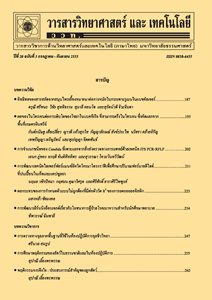Composition and Application of Ink from Cephalopods
Main Article Content
Abstract
Ink is a by-product of the squid processing that comes from household consumption or the seafood industry. The disposal of ink seems to cause environmental pollution. This research aimed to study the fundamental information and the application of cephalopod ink in 3 species, i.e. Bigfin reef squid (Sepioteuthis lessoniana), Pharaoh cuttlefish (Sepia pharaonis), and Marbled octopus (Amphioctopus aegina). The results showed that the moisture contents of those inks were 87.82±1.66, 85.08±0.70 and 85.57±0.12 %, and the pH values were 11, 8 and 10 in Bigfin reef squid, Pharaoh cuttlefish and Marbled octopus, respectively. The highest amount of protein content was from Bigfin reef squid ink (144.15±5.48 mg/mL), followed by Pharaoh cuttlefish ink (136.24±0.60 mg/mL) and Marbled octopus ink (104.17±0.68 mg/mL), which was significantly different at p < 0.05. The main color composition in the ink was predicted as melanin that revealed the maximum absorption (λmax) at 307 nm. Ink jelly was prepared for making a high value application. The proximate analysis of the ink jelly was shown 81.87-83.89 % moisture content, 1.52-1.92 % ash, 0.04-0.05 % crude protein, 0.02 % crude fat, and 14.18-16.06 % carbohydrate content. The colorimetric analysis showed the highest value of lightness, redness, yellowness and chroma in Pharaoh cuttlefish ink jelly and the highest value of hue angle in Marbled octopus ink jelly.
Article Details
References
Castillo, M.G., Salazar, K.A. and Joffe, N.R., 2015, The immune response of cephalopods from head to foot, Fish Shellfish Immunol. 46: 145-160.
Lee, P.N., Callaerts, P., de Couet, H.G. and Martindale, M.Q., 2003, Cephalopod hox genes and the origin of morphological novelties, Nature 424: 1061-1065.
Boyle, P. and Rodhouse, P., 2005, Cephalopods: Ecology and Fisheries, Blackwell Science, Oxford, 464 p.
Derby, C.D., 2014, Cephalopod ink: Production, chemistry, functions and applications, Marine Drugs 12: 2700-2730.
Suksangchan, C., 2015, Cephalopods, Department of Marine Science faculty of Fisheries, Kasetsart University, Bangkok, 130 p. (in Thai)
Myers, D., Is Squid ink the Next Big Health Food Trend, Available Source: https://www.thedailymeal.com/eat/squid-ink-next-big-health-food-trend, January 20, 2019.
Nair, J.R., Pillai, D., Joseph, S.M., Gomathi, P., Senan, P.V. and Sherief, P.M., 2011, Cephalopod research and bioactive substances, Indian J. Geo-Marine Sci. 40: 13-27.
Sasaki, J., Ishita, K., Takaya, Y., Uchisawa, H. and Matsue, H., 1997, Anti-tumor activity of squid ink, J. Nutr. Sci. Vitaminlo. 43: 455-461.
Rajaganapathi, J., Thyagarajan, S.P., Patterson Edward J.K., 2000, Study on cephalopod’s ink for anti-retroviral activity, Indian J. Exp. Biol. 38: 519-520.
Mimura, T., Maeda, K., Hariyama, H., Aonuma, S., Satake, M. and Fujita T., 1982, Studies on biological activities of melanin from marine animals, I. Purification of melanin from Ommastrephes bartrami Lesuel and its inhibitory activity on gastric secretion in rats, Chem. Pharm. Bull. 30: 1381-1386.
Lei, M., Wang, J., Wang, Y., Pang, L., Wang, Y., Xu, W. and Xue, C., 2007, Study of the radio-protective effect of cuttlefish ink on hemopoietic injury, Asia Pac. J. Clin. Nutr. 16: 239-243
Kim, S.Y., Kim, S.H. and Song, K.B., 2003, Characterization of an partial purification and angiotensin-converting enzyme inhibitor from squid ink, Agric. Chem. Biotechnol. 46: 122-123.
AOAC, 2000, Official Methods of Analysis, 15th Ed., Association of Official Analytical Chemists, Inc., Washington D.C., 1298 p.
Bradford, M.B., 1976, A rapid and sensitive method for quantitation of micrograms quantities of protein utilizing the principle of protein-dye binding, Anal. Biochem. 7: 248-254.
Guo, J., Rao, Z., Yang, T., Man, Z., Xu, M., and Zhang, X., 2014, High-level production of melanin by a novel isolate of Streptomyces kathirae, FEMS Microbiol. Lett. 357: 85-91.
Tangthongchit, T., 2012, How To Make Jelly, Phetpraguy, Inc., Bangkok, 120 p. (in Thai)
Somseang, S., 2007, Comparison of Color Change of Lychee [Lichi chinensis Sonn. (cv. Guang Jao)] Preserved by Ultra High Pressure and Heat Treatments, Master Thesis, Chiang Mai University, Chiang Mai, 108 p. (in Thai)
Brita, N.A., 2016, Antioxidant and antibacterial properties of cuttlefish ink collected from selected cuttlefish landed at Thoothukudi coast, Master Thesis, Tamil Nadu Fisheries University, Nagapattinam, 85 p.
Kollias, N., 1995, The Spectroscopy of Human Melanin Pigmentation, pp. 31-38, In Zeise, L., Chedekel, M.R., Fitzpatrick, T.B. (Eds.), Melanin: Its Role in Human Photoprotection, Valdenmar Publishing Co., Overland Park.
El-Naggar, N. and El-Ewasy, S., 2017, Bioproduction, characterization, anticancer and antioxidant activities of extracellular melanin pigment produced by newly isolated microbial cell factories Streptomyces glaucescens NEAE-H, Sci. Rep. 7: 1-19.
Mbonyiryivuze, A., Omollo, I., Balla, D.I., Mwakikunga, B., Simon, M.D., Park, E. and Maaza, M., 2015, Natural Dye Sensitizer for Grätzel Cells: Sepia Melanin, Physics and Materials Chemistry, 3: 1-6.
Takaya, Y., Uchisawa, H., Matsue, H., Okuzaki, B., Narumi, F., Sasaki, J. and Ishida, K., 1994, An investigation of the antitumor peptidoglycan fraction from squid ink, Biol. Pharm. Bull. 17: 846-919.
Zaharah, F. and Salleh, R.M., 2017, Antioxidant and antimicrobial activities of squid ink powder, Food Res. 2: 82-88.
Palumbo, A., D’Ischia, M., Misuraca, G., and Prota, G., 1987, Effect of metal ions on the rearrangement of dopachrome, Biochim. Biophys. Acta 925: 203-209.


